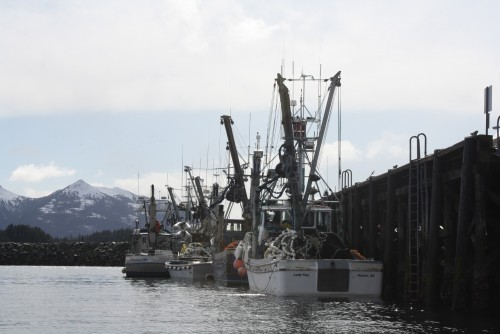
Seine boats await an opening at Crescent Harbor, prior to the 2012 Sitka Sound sac roe herring fishery. (KCAW photo/Ed Ronco)
Sitka’s spring herring fishery will be about 1,000 tons less than originally estimated, the Department of Fish & Game announced today.
The harvest limit for the herring fishery in Sitka Sound will be just over 16,000 tons. That’s about 7 percent lower than the preliminary harvest amount announced in December.
Herring management biologist Dave Gordon said the department revised the harvest level downward because sampling showed that the fish returning this year are smaller than last year. The revision is not unusual, he said.
“It seems like a lot, but the quota’s fairly large,” Gordon said. “So the change in tonnage may appear to some to be quite a bit, but percentage-wise, it’s nothing out of the norm.”
This year’s harvest limit is still much higher than last year’s, which was about 11,500 tons. Even with the lower limit, the fleet last year harvested only about half of its guideline harvest level.
Gordon said the primary reason for the low harvest was that the spawn took place too fast. Sitka Sound is a sac roe fishery. Fishermen focus on the herring eggs, or roe, and have to catch the herring before they spawn, when the eggs are still inside. When the spawn happens too quickly, the fleet simply can’t catch enough fish before they lay their eggs, Gordon said.
“The primary reason that we did not achieve the guideline harvest level was not because it was not enough fish,” Gordon said. “It was just the spawn happened so quickly that we were unable to catch pre-spawning herring, which you have to catch to get the product that this fishery demands. It’s a sac roe fishery, of course, and the eggs need to be in the herring for that to work.”
The Department of Fish & Game will start aerial surveys of Sitka Sound around March 14, Gordon said. The surveys look at the activity of marine mammals, and use their behavior to gauge the progress of the herring.
“We’re looking for the distribution of sea lions and whales to give us a handle on where herring are concentrated,” Gordon said. “At some point in time we will start to see changes in that distribution. The sea lions and whales will move in closer to shore, indicating herring are pulling in in preparation for spawning.”
The Department will use a combination of aerial surveys and test sampling to determine when to announce the start of the fishery, likely in late March.






























